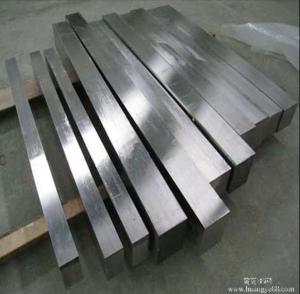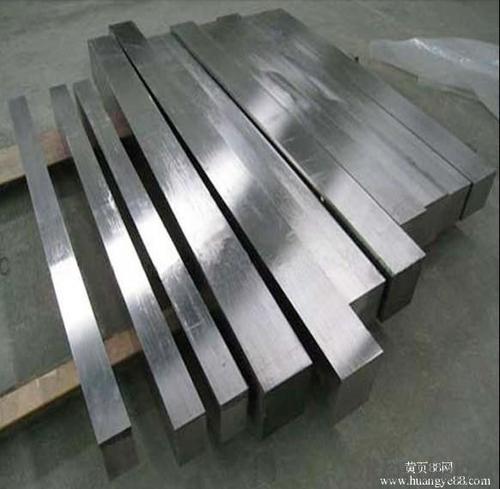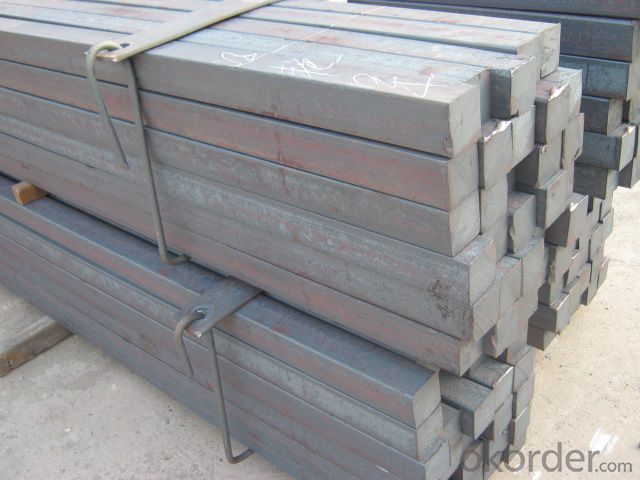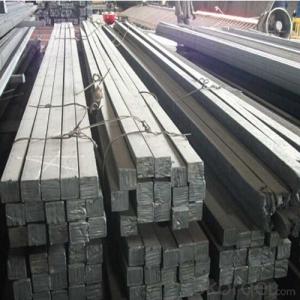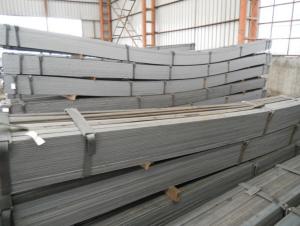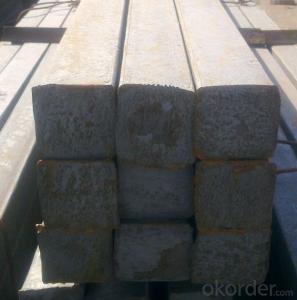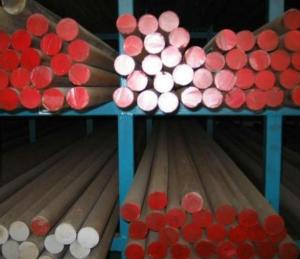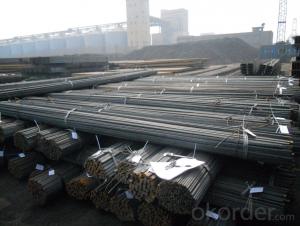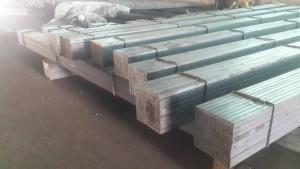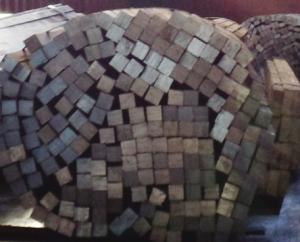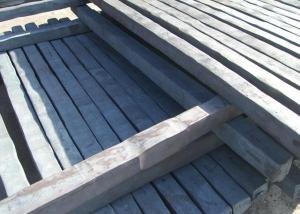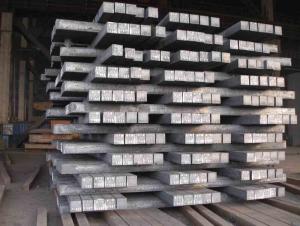high quality square steel bar
- Loading Port:
- China Main Port
- Payment Terms:
- TT OR LC
- Min Order Qty:
- -
- Supply Capability:
- -
OKorder Service Pledge
OKorder Financial Service
You Might Also Like
Product Description:
We offer Square Steel Bar with grade Q195 / Q235
Specifications of Square Steel Bar:
-Standard: GB,
-Grade: Q195/Q235 or equivalent.
Chemical Composition:
-Chemical Composition. Q195
Standard | Grade | Element (%) | ||||
GB | Q195 | C | Mn | S | P | Si |
0.06~0.12 | 0.25~0.50 | ≤0.050 | ≤0.045 | ≤0.30 | ||
-Chemical Composition. Q235
Standard | Grade | Element (%) | ||||
GB | Q235B | C | Mn | S | P | Si |
0.12~0.20 | 0.30~0.70 | ≤0.045 | ≤0.045 | ≤0.30 | ||
Measures and Tolerances of Square Steel Bar:
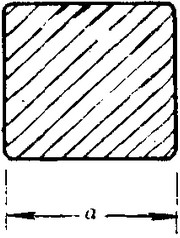
(The section of Square Steel Bar)
-The length of a side and the theoretical weight of Square Steel.
Length of a side(a, mm) | Theoretical weight(kg/m) | Length of a side(a, mm) | Theoretical weight(kg/m) |
6 | 0.283 | 32 | 8.04 |
7 | 0.385 | *33 | 8.55 |
8 | 0.502 | 34 | 9.07 |
9 | 0.636 | *35 | 9.62 |
10 | 0.785 | 36 | 10.17 |
11 | 0.950 | 38 | 11.24 |
12 | 1.13 | 40 | 12.56 |
13 | 1.33 | 42 | 13.85 |
14 | 1.54 | 45 | 15.90 |
15 | 1.77 | 48 | 18.09 |
16 | 2.01 | 50 | 19.63 |
17 | 2.27 | 53 | 22.05 |
18 | 2.54 | *55 | 23.6 |
19 | 2.82 | 56 | 24.61 |
20 | 3.14 | *58 | 26.4 |
21 | 3.46 | 60 | 28.26 |
22 | 3.80 | 63 | 31.16 |
*23 | 4.15 | *65 | 33.17 |
24 | 4.52 | *68 | 36.3 |
25 | 4.91 | 79 | 38.49 |
26 | 5.30 | 75 | 44.16 |
*27 | 5.72 | 80 | 50.24 |
28 | 6.15 | 85 | 56.72 |
*29 | 6.60 | 90 | 63.59 |
30 | 7.06 | 95 | 70.85 |
*31 | 7.54 | 100 | 78.50 |
Notes:
1, The theoretical weights in the list, base on the density of 7.85 g/cm3.
2, The numbers with *mean that they are not regulars or we don’t offer them.
-The allowed tolerance of Square Steel:
Length of a side(mm) | Allowed Tolerance | ||
Group1 | Group2 | Group3 | |
5.5~7 | ±0.20 | ±0.30 | ±0.40 |
7~20 | ±0.25 | ±0.35 | ±0.40 |
20~30 | ±0.30 | ±0.40 | ±0.50 |
30~50 | ±0.40 | ±0.50 | ±0.60 |
60~80 | ±0.60 | ±0.70 | ±0.80 |
80~110 | ±0.90 | ±1.0 | ±1.1 |
110~150 | ±1.2 | ±1.3 | ±1.1 |
150~190 | ―― | ―― | ±2.0 |
190~250 | ―― | ―― | ±2.5 |
Usage/Applications of Steel Square Bar:
-The Square Steel is normally used as structure steel.
-Row material for other structure steel like steel angles, channels, I-beams, H-beams, etc…
Packaging & Delivery of Steel Square Bar:
-Packing Detail: The products can be packed in bundles by steel wires.
-Marks:
1, Tag marks: the tag marks will be tied up to each bundle of the products. The information is usually including supplier’s logo and name, product name, made in China, products’ specifications, the painted color and other information requested by customers.
2, Color marks: we will paint both ends of the bundles of these products to make sure that they are more evident. It’s will be more convenient for the customers to distinguish them at the destination port.
-Delivery Detail: 30~45 working days after receive buyer’s T.T. or L/C.
Transportation:
-The products can be delivered by bulk vessel or by container. As for container, products with the length of 6m will be loaded in 20’ container, with 9m or 12m, in 40’ container.
-The maximum quantity of loading of container is 25 tons.
-The products usually are transported to the nearest port from the production place.
Payment:
-Invoicing on theoretical weight or actual weight a s customer’s request.
-FOB, CFR or CIF.
-Regular terms of payment:
1, 30% payment in advance, the remaining balance (70% payment) against the copy of B/L.
2, 30% payment in advance, the remaining balance (70% L/C) against the copy of B/L.
3, Negotiable.
- Q: Can a steel square be used for checking the flatness of a surface?
- No, a steel square is not typically used for checking the flatness of a surface. It is primarily used for measuring right angles and ensuring accuracy in woodworking and metalworking projects. For checking flatness, other tools such as a straight edge or surface plate are more suitable.
- Q: The steel structure material can do?
- The square can be built steel shed, small steel shed are built with square, purlin is divided into 98% major plant two 4*6 and 4*8 5*10 are not a pillar or beam with the tube, because not standard
- Q: How do you use a steel square to find the correct angle for a miter joint?
- To use a steel square to find the correct angle for a miter joint, you can place the square against the edge of the material you are working with, ensuring that one arm of the square is aligned with the edge. Then, rotate the material until the desired angle is achieved and mark the position. This angle can be used as a guide for cutting and assembling the miter joint accurately.
- Q: Can a steel square be used for framing?
- Yes, a steel square can be used for framing. A steel square, also known as a framing square or carpenter's square, is a versatile tool commonly used in construction and woodworking. While traditional framing squares are typically made of wood or aluminum, steel squares offer additional durability and sturdiness. They consist of a long arm (body) and a shorter arm (tongue) that meet at a 90-degree angle, forming an L-shape. The body of the square is usually 24 inches long, and the tongue is usually 16 inches long. Steel squares have various markings and measurements along their edges, which make them useful for framing tasks. They can be used to lay out and mark straight lines, accurately measure angles, determine levelness and squareness, and check the alignment of walls, doors, windows, and other components during the framing process. Steel squares are especially beneficial when working with metal framing or when extra strength and durability are required. They are also resistant to warping and bending, ensuring precise measurements and reliable results. In summary, a steel square is a suitable tool for framing purposes due to its strength, durability, and versatility. It is commonly used by carpenters, construction workers, and woodworkers to ensure precise and accurate framing measurements and alignments.
- Q: How do you use a steel square to determine the length of a stringer?
- To use a steel square to determine the length of a stringer, you would follow these steps: 1. Start by placing the steel square on the edge of the stringer. Ensure that one arm of the square is aligned with the edge of the stringer, and the other arm is perpendicular to it. 2. Slide the square along the stringer until the perpendicular arm reaches the desired length of the stringer. 3. Once the square is in position, make a mark on the stringer where the perpendicular arm of the square ends. 4. Remove the steel square and use a tape measure or ruler to measure the distance between the mark and the starting point of the stringer. This measurement will give you the accurate length of the stringer. It's important to note that a steel square is a versatile tool used in various carpentry and construction tasks. Its L-shaped design allows for accurate measurements and precise angles. By using it correctly, you can ensure accurate and precise measurements for your stringer or any other woodworking project.
- Q: How do you use a steel square to find the center of a round object?
- To use a steel square to find the center of a round object, you can follow these steps: 1. Place the round object on a flat surface, ensuring it is stable and doesn't wobble. 2. Take the steel square and position one of its edges against the side of the round object. 3. Make sure the steel square is perpendicular to the surface on which the round object is placed. 4. Hold the steel square firmly against the round object, ensuring it doesn't move or slide. 5. Look at the point where the other edge of the steel square intersects with the round object. This point is the approximate center of the round object. 6. To get a more accurate center, repeat the process from different angles, ensuring the steel square remains perpendicular to the surface each time. 7. Where the different lines intersect or meet each other is the precise center of the round object. By using a steel square in this manner, you can find the center of a round object with relative accuracy, which can be useful for various purposes such as marking, cutting, or drilling.
- Q: How do you use a steel square to determine the pitch of a roof?
- To determine the pitch of a roof using a steel square, you can follow these steps: 1. Start by placing the steel square on the roof, with one leg (blade) resting on the horizontal surface (roof) and the other leg (tongue) hanging down vertically. 2. Align the tongue of the steel square with the roof surface, making sure it is perfectly vertical. 3. Take a level and place it on the tongue of the steel square, ensuring it is level horizontally. 4. Next, measure the distance between the point where the tongue of the steel square meets the roof and the level bubble. This measurement represents the rise of the roof. 5. Then, measure the distance between the point where the tongue meets the roof and the blade of the steel square. This measurement represents the run of the roof. 6. Finally, divide the rise by the run to calculate the pitch ratio or slope of the roof. By using a steel square in this manner, you can accurately determine the pitch of a roof.
- Q: Can a steel square be used for checking the plumbness of a support column?
- Indeed, a support column's plumbness can be assessed using a steel square. Commonly employed in construction and carpentry, the steel square is an adaptable tool. Possessing a right angle, it allows for the examination of verticality or plumbness of surfaces. By positioning the steel square against the support column and aligning it with the surface, one can effortlessly ascertain if the column is straight or necessitates adjustments to achieve plumbness. Due to its reliability and precision, the steel square serves as an appropriate instrument for inspecting the plumbness of support columns.
- Q: What are some common uses of a steel square in welding?
- A steel square, a versatile tool widely used in welding, has numerous applications. Some common uses of a steel square in welding include the following: 1. Ensuring Right Angles: The primary purpose of a steel square is to guarantee that welded joints are perfectly right angles, thus maintaining the structural integrity of the workpiece. 2. Accurate Measurement and Marking: With graduated scales along their edges, steel squares enable welders to measure and mark different lengths precisely. This ensures precise dimensions for welded components. 3. Layout and Pattern Creation: Steel squares are often employed in layout work to mark and create patterns, templates, and cut lines on metal surfaces. They allow welders to create perpendicular lines, parallel lines, and scribe circles and arcs. 4. Alignment Checking: Steel squares are handy for checking the alignment of welded components. Whether it's ensuring perfect alignment before welding or checking the alignment of a welded joint, a steel square ensures accurate alignment. 5. Checking Flatness and Squareness: Welders frequently use steel squares to verify the flatness and squareness of welded surfaces. By placing the square against the surface or weld, they can determine if the area is flat or if the edges are square. 6. Setting Up Welding Tables: Steel squares are useful for aligning and squaring the framework of welding tables, ensuring a stable and level surface for welding operations. 7. Fabrication and Assembly: Steel squares are commonly employed in the fabrication and assembly of welded structures. They aid in positioning and aligning components during the welding process, resulting in accurate and strong welds. In conclusion, a steel square is an indispensable tool in a welder's arsenal, providing accuracy, precision, and reliability for various welding applications.
- Q: How do you use a steel square to measure the width of a countertop?
- In order to measure the width of a countertop using a steel square, the first step is to position one arm of the square flush against one edge of the countertop. It is important to ensure that the square is perfectly aligned perpendicular to the edge of the countertop. Next, extend the other arm of the square across the width of the countertop until it reaches the opposite edge. Take note of the measurement on the scale of the square where the edge of the countertop intersects with the other arm of the square. This measurement will indicate the width of the countertop. To ensure accuracy, it is crucial to firmly hold the square in place while taking the measurement.
Send your message to us
high quality square steel bar
- Loading Port:
- China Main Port
- Payment Terms:
- TT OR LC
- Min Order Qty:
- -
- Supply Capability:
- -
OKorder Service Pledge
OKorder Financial Service
Similar products
Hot products
Hot Searches
Related keywords
